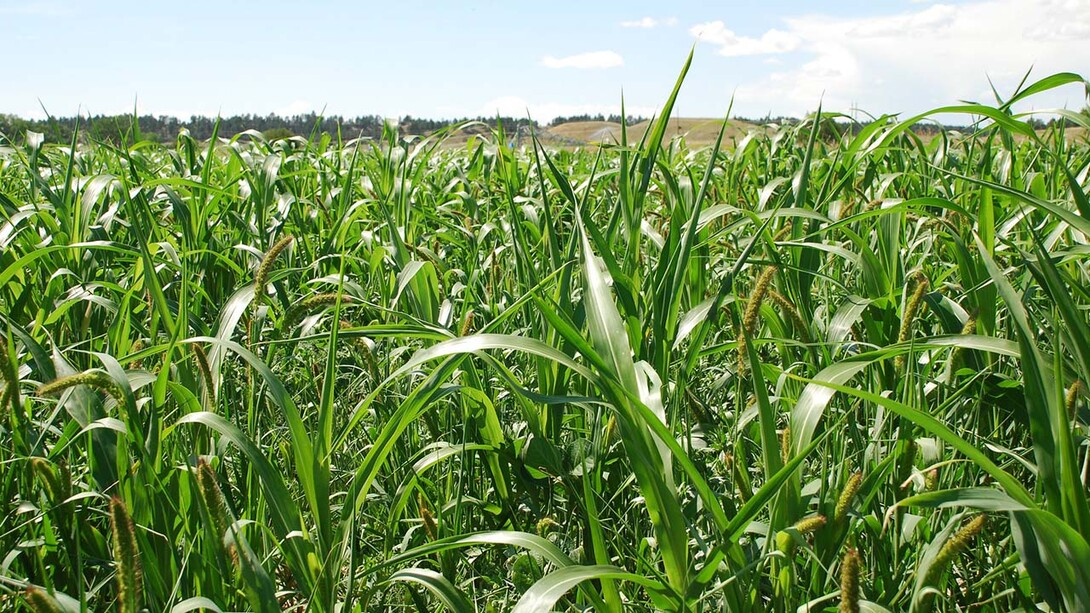
The majority of Nebraska farms with more than 1,000 acres of cropland utilized at least one of the regenerative cropping practices of planting cover crops, no-till and reduced tillage between 2012 and 2017, according to the most recent data available from the U.S. Department of Agriculture’s 2017 Census of Agriculture.
These are among the most common practices for sequestering carbon and potentially becoming eligible to earn carbon credits from organizations and aggregators currently participating in private voluntary carbon markets. A recent analysis by the University of Nebraska–Lincoln’s Center for Agricultural Profitability looks at USDA data related to the use of all three practices on Nebraska farms between 2012 and 2017 to gauge the status of producers’ participation in environmental credit markets.
According to the census, there were 38,084 cropland farms in Nebraska in 2017, representing more than 22 million acres. About 73% of Nebraska cropland was included on farms of 1,000 acres or more.
The number of farms utilizing cover crops, no-till and reduced tillage is not mutually exclusive, meaning that a farm can employ a combination of the three practices across its acreage. And some farms that utilize one or more of these practices do so on only a portion of their acres.
No-till practices were the most widely used of the three practices across the state, employed on 51% of the acreage on farms with 1,000 to 1,999 acres and on 45% of the acreage on farms with more than 2,000 acres. Reduced tillage practices (excluding no-till) were used on 29% of the acreage on farms with 1,000 to 1,999 acres and on 26% of farms with more than 2,000 acres.
The utilization of cover crops — employed on about 3% of the acreage on farms in both the 1,000-to-1,999-acre and 2,000-plus-acre categories — trailed the usage rates of no-till and reduced tillage practices. However, the amount of cropland acres planted to cover crops on Nebraska farms grew by 109% between 2012 and 2017, compared to more modest growth during the same period in the proportion of acres using reduced tillage (20%) and no-till (9%) practices.
Larry Van Tassell, director of the Center for Agricultural Profitability, attributed the increase in cover crop use, in part, to the rising recognition of their ecological advantages and government incentives for producers.
“The environmental and soil quality benefits, coupled with the cost-share programs offered by the Natural Resources Conservation Service, have helped to drive the appeal of cover crops, in particular,” he said.
In addition to being eligible for carbon credit payments in existing private markets and possible future public markets, sequestration practices such as planting cover crops, no-till and reduced tillage have other economic benefits for producers, according to Van Tassell.
“According to UNL enterprise budgets, and many field studies, greater yields are experienced with no-till practices compared to conventional tillage, with cost per bushel of production averaging lower with no-till,” he said. “Cover crops will often not show an immediate profit, but soil and water health are the great motivators.”
Compared to Iowa, Kansas and South Dakota, Nebraska producers have been leaders in utilizing these three practices. The state had a larger percentage of all farms (45%), as well as a greater percentage of acreage on those farms (46%), using no-till practices than each of the other three states, as well as the United States as a whole. Nebraska trailed only Iowa in both the percentage of total cropland planted to cover crops (3%) and the percentage of total cropland using reduced tillage (26%).
“Nebraska farmers have been relatively early adopters when it comes to conservation land-use practices, so a number of Nebraska producers are already positioned to participate in carbon markets,” Van Tassell said. “It also appears that there is still a large amount of acreage than can be positioned to engage in these markets.”
As private environmental markets continue to grow, a more transparent public voluntary market appears to be getting closer with the passage of the Growing Climate Solutions Act in the Senate on June 24. If enacted, it would direct the USDA to develop a program to facilitate the participation of farmers, ranchers and private forest landowners in such a market. The act has identified planting cover crops, no-till and reduced tillage as practices that would potentially be eligible for payment in voluntary carbon markets.
Dave Aiken, a professor in the university’s Department of Agricultural Economics, said that additionality — a principle that may require the producer to do something different, in addition to what they have been doing, to contribute to climate solutions and earn carbon credits — has caught the attention of many in agriculture due to the term’s presence in the Growing Climate Solutions Act. But he noted the importance of distinguishing between compliance and voluntary markets.
“The Growing Climate Solutions Act deals with voluntary markets, not compliance markets,” Aiken said. “There are ongoing conversations about whether today’s voluntary markets should have the same rules as the original compliance or regulatory markets.”
Aiken said that, while much is still uncertain, voluntary markets are not expected to have additionality requirements in the near term, though he noted that the additionality debate is likely to continue as carbon policies are developed to respond to climate change.
Van Tassell said he believes the use of conservation cropping practices will continue to grow, both because Nebraska producers are good stewards of the land and because the economic benefits will continue to appeal to farmers.
“If these public ecosystem services markets come to fruition, there will be greater incentive to increase the number of acres in reduced tillage, no-till and cover crop practices,” he said.
For the recent analysis of conservation practices on Nebraska cropland, more on the Growing Climate Solutions Act and additionality, as well as many other resources related to agricultural carbon markets in Nebraska, visit the Center for Agricultural Profitability’s website here.







